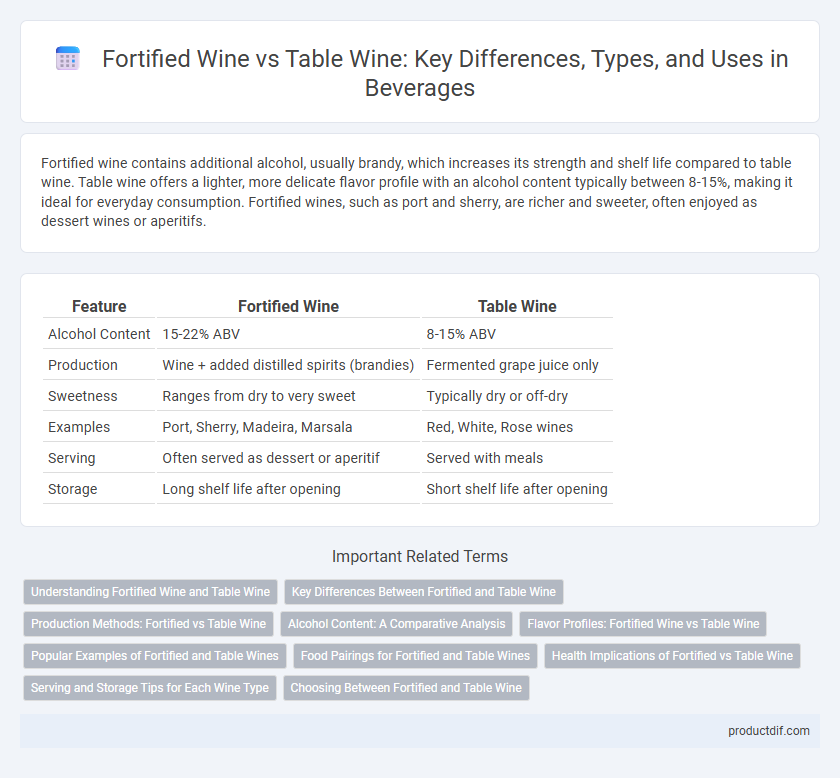Fortified wine contains additional alcohol, usually brandy, which increases its strength and shelf life compared to table wine. Table wine offers a lighter, more delicate flavor profile with an alcohol content typically between 8-15%, making it ideal for everyday consumption. Fortified wines, such as port and sherry, are richer and sweeter, often enjoyed as dessert wines or aperitifs.
Table of Comparison
| Feature | Fortified Wine | Table Wine |
|---|---|---|
| Alcohol Content | 15-22% ABV | 8-15% ABV |
| Production | Wine + added distilled spirits (brandies) | Fermented grape juice only |
| Sweetness | Ranges from dry to very sweet | Typically dry or off-dry |
| Examples | Port, Sherry, Madeira, Marsala | Red, White, Rose wines |
| Serving | Often served as dessert or aperitif | Served with meals |
| Storage | Long shelf life after opening | Short shelf life after opening |
Understanding Fortified Wine and Table Wine
Fortified wine is a type of wine enhanced with distilled spirits, typically brandy, increasing its alcohol content to around 17-20%, which distinguishes it from standard table wine that usually contains 9-15% alcohol. Common examples of fortified wines include Port, Sherry, and Madeira, each offering richer flavors and longer shelf life due to fortification. Table wine, produced solely through fermentation without additional spirits, is widely consumed for everyday drinking and pairs well with various foods because of its balanced alcohol level and flavor profile.
Key Differences Between Fortified and Table Wine
Fortified wine contains added spirits, usually brandy, increasing its alcohol content to 17-20%, while table wine typically ranges from 9-15% alcohol by volume. Fortified wines like port and sherry often have a richer, sweeter profile and longer shelf life due to higher alcohol and sugar content. Table wines, made from fermented grape juice without added spirits, exhibit a wider variety of flavors that depend on grape variety, region, and aging process.
Production Methods: Fortified vs Table Wine
Fortified wine undergoes a unique production process where grape spirit or brandy is added during or after fermentation, resulting in higher alcohol content and enhanced preservation. Table wine is produced by fermenting grape juice through yeast conversion of sugars without additional spirits, yielding a lower alcohol content and a more delicate flavor profile. The fortification step in fortified wines also halts fermentation early, preserving natural sugars and creating a sweeter, richer beverage compared to the typically dry table wine.
Alcohol Content: A Comparative Analysis
Fortified wine contains higher alcohol content, typically ranging from 17% to 20%, due to the addition of distilled spirits during production. Table wine usually has an alcohol content between 11% and 15%, depending on the grape variety and fermentation process. This difference significantly impacts flavor intensity and aging potential in both wine categories.
Flavor Profiles: Fortified Wine vs Table Wine
Fortified wine offers a richer, more intense flavor profile characterized by higher alcohol content and pronounced notes of caramel, nuts, and dried fruits, due to the addition of distilled spirits. Table wine typically exhibits lighter, more delicate flavors with a balance of acidity, fruitiness, and tannins, reflecting the grape variety and terroir. The complexity of fortified wine's flavor profile makes it ideal for sipping or pairing with rich desserts, while table wine's versatility suits a wider range of meals.
Popular Examples of Fortified and Table Wines
Popular examples of fortified wines include Port, Sherry, and Madeira, which are known for their higher alcohol content and rich, concentrated flavors. Table wines, such as Cabernet Sauvignon, Chardonnay, and Merlot, are typically lower in alcohol and consumed with meals for their balanced taste profiles. Both categories offer distinct tasting experiences, with fortified wines often used in dessert or aperitif settings, while table wines complement everyday dining.
Food Pairings for Fortified and Table Wines
Fortified wines, such as Port or Sherry, pair exceptionally well with rich, savory dishes like blue cheese, nuts, and charcuterie, as their higher alcohol and sweetness balance intense flavors. Table wines, including red and white varieties, complement a broader range of foods, from light salads and seafood with crisp whites to grilled meats and hearty pasta with bold reds. Selecting the right wine enhances the dining experience by harmonizing acidity, tannins, and sweetness with the texture and flavor profile of the food.
Health Implications of Fortified vs Table Wine
Fortified wine contains higher alcohol content, typically ranging from 15% to 22%, which can increase the risk of liver damage and other alcohol-related health issues compared to table wine with 9% to 14% alcohol. The added spirits in fortified wines also result in higher calorie content, potentially contributing to weight gain and metabolic concerns. Moderate consumption of table wine, especially varieties rich in antioxidants like resveratrol, may offer cardiovascular benefits, whereas excessive intake of fortified wine poses greater health risks.
Serving and Storage Tips for Each Wine Type
Fortified wine, such as Port or Sherry, should be served slightly chilled at 55-65degF and stored in a cool, dark place with the bottle tightly sealed to maintain its high alcohol content and flavor profile. Table wine is best served chilled between 45-55degF for whites and lightly chilled at 55-65degF for reds, and it should be stored on its side in a wine rack at a consistent temperature around 55degF to preserve its freshness and tannin structure. After opening, fortified wines can last several weeks due to their added spirits, whereas table wines typically need to be consumed within a few days when resealed and refrigerated.
Choosing Between Fortified and Table Wine
Choosing between fortified wine and table wine depends on the desired alcohol content and flavor intensity. Fortified wines like Port and Sherry contain added distilled spirits, resulting in higher alcohol levels around 17-20%, making them ideal for sipping or dessert pairing. Table wines, typically with 11-15% alcohol, offer lighter body and diverse varietals suited for casual meals and everyday drinking.
Fortified Wine vs Table Wine Infographic

 productdif.com
productdif.com